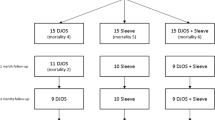Abstract
Background: Factors leading to weight loss and weight stabilization after bariatric surgery are not fully understood. The aims of this study were to develop an animal model for biliopancreatic diversion (BPD) and to determine changes in gut hormones, malabsorption and small bowel histology postoperatively.
Methods: 2 groups of Wistar rats underwent sham and BPD surgery. Daily postoperative weights and food intake were measured. 24-hour fecal collections were performed at Day 6 and 21. Bomb calorimetry was performed to determine the fecal calorific values. At day 23, levels of peptide YY (PYY), glucagon-like peptide 1 (GLP-1) and glucagon-like peptide 2 (GLP-2) were determined and small bowel biopsies were taken.
Results: Animals in the BPD group had significant reduction in weight (P<0.001) and in food intake (P<0.001) compared to the sham group. Serum levels of PYY, GLP-1 and GLP-2 in the BPD group were significantly higher (P<0.005). Animals in the BPD group had significantly higher fecal energy content at Day 6 (P<0.001) but not at Day 21 when compared to the sham group. Small bowel histology confirmed the presence of significantly increased mitosis (P=0.03) and labelled cells (P=0.002) in the BPD animals when compared to sham.
Conclusions: In our animal model, the higher levels of PYY, GLP-1 and GLP-2 after BPD may be due to gut adaptation and hypertrophy and could be important in inducing and maintaining weight loss after bariatric surgery.
Similar content being viewed by others
References
Sjostrom L, Lindroos AK, Peltonen M et al. Lifestyle, diabetes, and cardiovascular risk factors 10 years after bariatric surgery. N Engl J Med 2004; 351: 2683–93.
Scopinaro N, Gianetta E, Adami GF et al. Biliopancreatic diversion for obesity at eighteen years. Surgery 1996; 119: 261–8.
Atkinson RL, Brent EL. Appetite suppressant activity in plasma of rats after intestinal bypass surgery. Am J Physiol 1982; 243: R60-R64.
Adrian TE, Ferri GL, Bacarese-Hamilton AJ et al. Human distribution and release of a putative new gut hormone, peptide YY. Gastroenterology 1985; 89: 1070–7.
Lundberg JM, Tatemoto K, Terenius L et al. Localization of peptide YY (PYY) in gastrointestinal endocrine cells and effects on intestinal blood flow and motility. Proc Natl Acad Sci USA 1982; 79: 4471–5.
Batterham RL, Cowley MA, Small CJ et al. Gut hormone PYY(3–36) physiologically inhibits food intake. Nature 2002; 418: 650–4.
Batterham RL, Cohen MA, Ellis SM et al. Inhibition of food intake in obese subjects by peptide YY3–36. N Engl J Med 2003; 349: 941–8.
Kreymann B, Williams G, Ghatei MA et al. Glucagon-like peptide-1 7–36: a physiological incretin in man. Lancet 1987; 2: 1300–4.
Gutzwiller JP, Drewe J, Goke B et al. Glucagon-like peptide-1 promotes satiety and reduces food intake in patients with diabetes mellitus type 2. Am J Physiol 1999; 276: R1541-R1544.
Farilla L, Bulotta A, Hirshberg B et al. Glucagon-like peptide 1 inhibits cell apoptosis and improves glucose responsiveness of freshly isolated human islets. Endocrinology 2003; 144: 5149–58.
Clements RH, Gonzalez QH, Long CI et al. Hormonal changes after Roux-en Y gastric bypass for morbid obesity and the control of type-II diabetes mellitus. Am Surg 2004; 70: 1–4.
Pories WJ, Swanson MS, MacDonald KG et al. Who would have thought it? An operation proves to be the most effective therapy for adult-onset diabetes mellitus. Ann Surg 1995; 222: 339–50.
Borg CM, Le Roux CW, Ghatei MA et al. Progressive rise in gut hormone levels after Roux-en-Y gastric bypass suggests gut adaptation and explains altered satiety. Br J Surg 2006; 93: 210–5.
Drucker DJ. Biologic actions and therapeutic potential of the proglucagon-derived peptides. Nat Clin Pract Endocrinol Metab 2005; 1: 22–31.
Miller DS, Payne PR. A ballistic bomb calorimeter. Br J Nutr 1959; 13: 501–8.
Nadreau E, Baraboi ED, Samson P et al. Effects of the biliopancreatic diversion on energy balance in the rat. Int J Obes 2006; 30: 419–29.
Rubino F, Marescaux J. Effect of duodenal-jejunal exclusion in a non-obese animal model of type 2 diabetes: a new perspective for an old disease. Ann Surg 2004; 239: 1–11.
Allen JM, Fitzpatrick ML, Yeats JC et al. Effects of peptide YY and neuropeptide Y on gastric emptying in man. Digestion 1984; 30: 255–62.
Mason EE. Ileal [correction of ilial] transposition and enteroglucagon/GLP-1 in obesity (and diabetic?) surgery. Obes Surg 1999; 9: 223–8.
Näslund E, Gryback P, Hellstrom PM et al. Gastrointestinal hormones and gastric emptying 20 years after jejunoileal bypass for massive obesity. Int J Obes 1997; 21: 387–92.
Näslund E, Backman L, Holst JJ et al. Importance of small bowel peptides for the improved glucose metabolism 20 years after jejunoileal bypss for obesity. Obes Surg 1998; 8: 253–60.
Author information
Authors and Affiliations
Corresponding author
Rights and permissions
About this article
Cite this article
Borg, C.M., le Roux, C.W., Ghatei, M.A. et al. Biliopancreatic diversion in rats is associated with intestinal hypertrophy and with increased GLP-1, GLP-2 and PYY levels. OBES SURG 17, 1193–1198 (2007). https://doi.org/10.1007/s11695-007-9211-2
Received:
Accepted:
Issue Date:
DOI: https://doi.org/10.1007/s11695-007-9211-2




